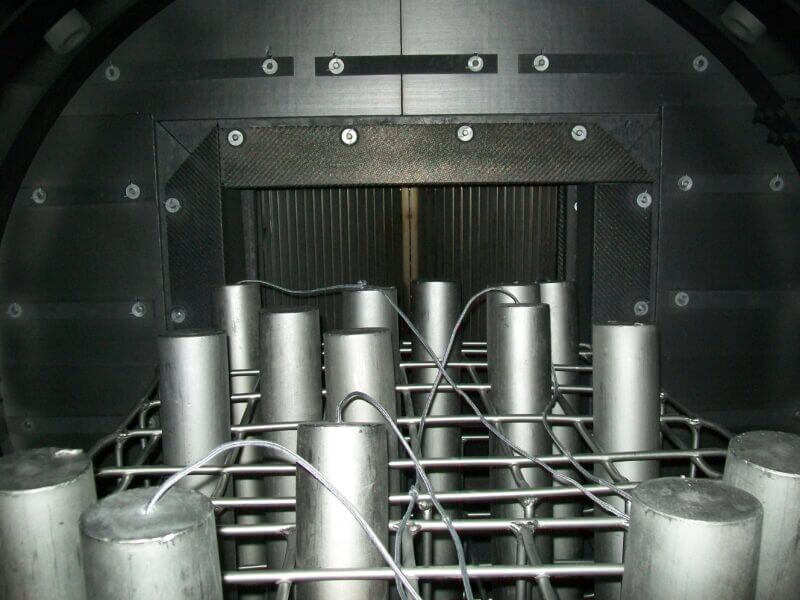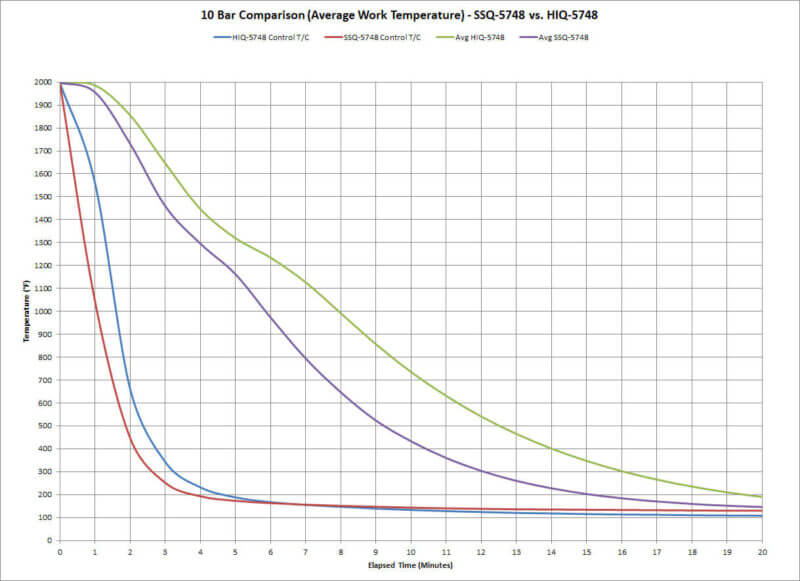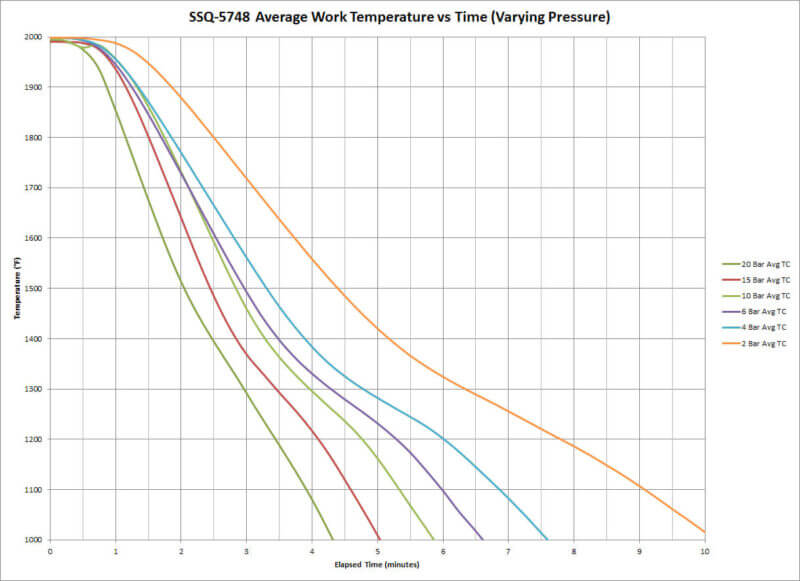Maximizing Vacuum Furnace Gas Quenching Performance
Introduction
There are many areas that engineers must consider when attempting to design a new and high performance gas quenching vacuum furnace. Some critical areas of concern include:
- Proper fan design to achieve maximum gas flow
- Creating a minimal flow resistance path for the re-circulating gas
- Consideration of the types of cooling gasses to be used
- A method to optimize the cooling system’s available power
Most furnaces are typically designed to operate at maximum pressure for a given gas type. This results in a sacrifice of system performance at pressures lower than the design pressure resulting in longer cycle time. This also creates extreme limitations on the vacuum furnace performance when implementing other gasses.
Illustrating the above, when a furnace is designed for optimal performance using nitrogen gas, the user must accept limited performance when using argon gas. Using argon as well as nitrogen is often a requirement in many heat treating facilities. This results in lower quench pressure and/or slower fan speed to compensate for the change in gas density.
These conventional designs do not utilize full system potential and therefore forfeit quench speed again resulting in longer cycle times and also the possibility of not being able to quench certain materials.
Synchronous Design Concept
In order to overcome many of the factors highlighted above that exist on current conventional furnaces, our new high pressure quench furnace incorporates a synchronous design concept. Key components of this design include:
- Utilizing a Variable Frequency Drive (VFD) to “over-speed” the cooling fan motor
- Selecting a specially designed motor that can withstand the “over-speed” conditions
- Designing an appropriately sized fan to operate across the entire pressure range
Comparing Synchronous to Conventional Design For Two Gasses
Different from the conventional design, the synchronous approach allows the cooling system of the furnace to operate at the high motor speed range using nitrogen and at a slightly reduced speed with argon while maintaining the same pressure and using full horsepower because it is still operating above synchronous motor speed. The following chart is normalized to compare the relative performance of each system when using nitrogen and argon gas.
| Conventional Design | Synchronous Design | |||
| Nitrogen | Argon | Nitrogen | Argon | |
| Pressure (P) – Bar(a) | 2 | 1.45 | 2 | 2 |
| Density (r) – lb./cu.ft. | 0.148 | 0.148 | 0.148 | 0.204 |
| Speed (N) – RPM | 3600 | 3600 | 3600 | 3234 |
| Product of P x N | 7200 | 5220 | 7200 | 6468 |
| Relative HP Used (%) | 100 | 100 | 100 | 100 |
Equating the relative performance of the two systems we have:
- Nitrogen – 7200/7200 = 1 The two systems provide equal relative cooling for nitrogen at this pressure.
- Argon – 6468/5220 = 1.24 This illustrates the improved relative cooling (24% better) when using argon in the synchronous system as compared to the conventional system.
Applying the Synchronous Design the New 20 Bar Vacuum Furnace
The synchronous design with its VFD was recently incorporated into our newest 20 Bar Super Quench Vacuum Furnace (SSQ). This recently manufactured and installed system has now gone through an extensive testing program to fully compare its performance to prior conventional designs.
This furnace has a work zone that measures 36” wide x 36” high x 48” deep with a gas cooling system incorporating a 300 HP motor. The following test load was selected to represent a typical load for this size furnace and has been used on all tests and illustrations that follow.
The test load was as follows:
- 20 Steel Bars – each measuring 3” O.D. x 28” Long
- 6 Work Baskets and 1 Supporting Grid
- Total load weight was approximately 1300 lbs.
- 7 T/C’s were used throughout the load to measure the core temperature
The Cooling Test Procedure was as follows:
- The same load was used for all tests
- Nitrogen was used as the cooling gas
- The load would be quenched from 2000oF
- The quench pressure was varied to obtain performance data
- Quench pressures were 2, 4, 6, 10, 15, and 20 Bar
Comparison of Conventional 10 Bar Furnace and Synchronous Design Cooling at 10 Bar
In order to demonstrate the improved cooling of the newly designed 20 Bar furnace, we proceeded with a test in one of our 10 Bar furnaces cooling at 10 Bar pressure using the same load and compared that with a test from the 20 Bar furnace cooling at 10 Bar. The 10 Bar conventional design is identified as the HIQ-5748 furnace while the 20 Bar furnace is identified as the SSQ-5748 furnace. The following curve illustrates the significant improvement of the synchronous design versus the conventional design.
**One additional note: We were curious to determine how much better the synchronous design was than the conventional design. The synchronous design cooling at 4 Bar backfill pressure produced the same cooling performance as the conventional design cooling at 10 Bar backfill pressure. That means we achieved the same results using 60% less gas!
Chart Illustrating the Performance Data at Different Backfill Pressures
The following Chart illustrates the unique varying components of the synchronous design as pressure increases.
| Gas Backfill Pressure | Frequency (Hz) | Motor Speed (RPM) | Motor Current (Amperes) |
| 2 Bar | 113 | 3291 | 325 |
| 4 Bar | 90 | 2628 | 334 |
| 6 Bar | 77 | 2261 | 327 |
| 10 Bar | 63 | 1850 | 314 |
Testing SSQ-5748 at Various Gas Pressures
The next series of tests involved processing the same test load across various gas pressures ranging from 2 Bar to 20 Bar. This illustrated the excellent cooling rates that can be achieved using the synchronous design.
These results also demonstrated cooling rates that could be applied to certain oil quench grade materials to achieve desired properties that were previously thought not possible with gas quenching. Further studies are now underway to establish which materials of a given cross-section could be processed in this style furnace.
Conclusions
Based on our test data, we can conclude the following:
- Incorporating a VFD into a gas quenching system allows for excellent versatility regarding gas cooling at different pressures and when using different gas types.
- Operating at or above synchronous motor speed maximizes system performance.
- The synchronous design concept allows for using the largest possible fan to maximize efficiency across the entire pressure range.
- The SSQ furnace will allow gas quenching to replace oil quenching on certain materials thus greatly improving part stability and any need for further post process operations.
Written By – Nicholas Cordisco – Electrical Engineer – Solar Manufacturing Inc.
Contributor – Real J. Fradette – Senior Technical



